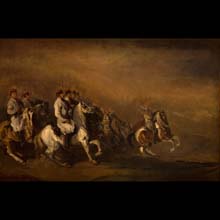
material: oil on canvas
dimensions: 60 x 90 cm
description: This work is part of the so-called “Krakusi” series, made up of several oils as well as watercolours and drawings in various stages of completion. The series illustrates the events of the November Uprising, in which participated two regiments of the Krakusi – the insurrectionary cavalry consisting of the citizens from the former Krakow region. Their picturesque uniforms were inspired by the regional costumes and the insurrectionary tradition. A great many of the painter’s relatives and acquaintances fought in the ranks of the Krakus cavalry and their accounts had an enormous impact on his imagination, especially that, having been ordered by the commander in chef to organize the manufacture of weapons and munitions for the uprising forces in the governmental ironworks in Białogon in the Kielce region, which were under his authority, he could not take direct part in the fight. The painting (although the figure of the commander is only roughly sketched) represents high artistic values: an elaborate palette, a sense of form and rhythm, pronounced texture and visible, fluid brushwork. Anna Zeńczak
exposition: The Gallery of 19th Century Polish Art in Sukiennice,
The Cloth Hall, 1, Main Market Square
key: Romanticism. Towards national art >>>
dimensions: 60 x 90 cm
description: This work is part of the so-called “Krakusi” series, made up of several oils as well as watercolours and drawings in various stages of completion. The series illustrates the events of the November Uprising, in which participated two regiments of the Krakusi – the insurrectionary cavalry consisting of the citizens from the former Krakow region. Their picturesque uniforms were inspired by the regional costumes and the insurrectionary tradition. A great many of the painter’s relatives and acquaintances fought in the ranks of the Krakus cavalry and their accounts had an enormous impact on his imagination, especially that, having been ordered by the commander in chef to organize the manufacture of weapons and munitions for the uprising forces in the governmental ironworks in Białogon in the Kielce region, which were under his authority, he could not take direct part in the fight. The painting (although the figure of the commander is only roughly sketched) represents high artistic values: an elaborate palette, a sense of form and rhythm, pronounced texture and visible, fluid brushwork. Anna Zeńczak
exposition: The Gallery of 19th Century Polish Art in Sukiennice,
The Cloth Hall, 1, Main Market Square
key: Romanticism. Towards national art >>>












